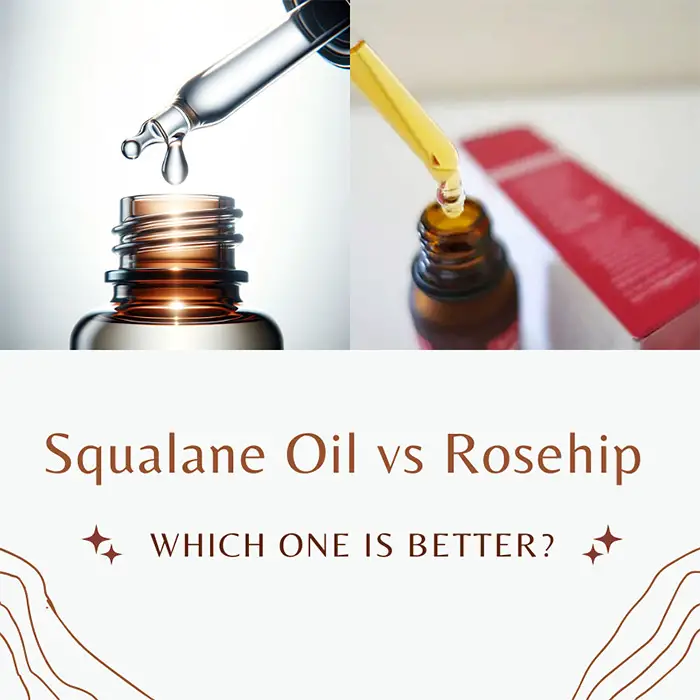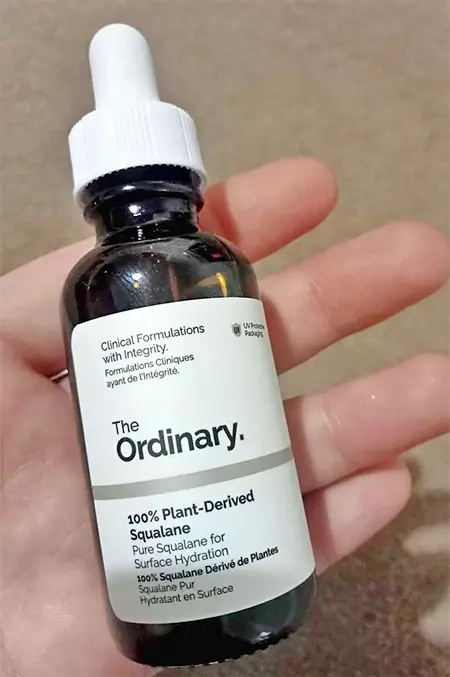
When it comes to facial oils, squalane and rosehip oil are currently two of the most popular in the beauty industry. They have amazing benefits ranging from skin barrier repair, hydration, controlling acne, and uneven skin tone. There is a lot to unpack between these two star oils.
In this article, we are going to compare squalane vs rosehip oil and help you decide which is better for you. Here you will also find out how to use them on your skin and if they can be used together.
Table of Contents
- Exploring Squalane Oil: The Moisture Marvel
- Rosehip Oil: A Natural Radiance Booster
- Plant-derived Squalane Oil vs Rosehip Oil
- Hemi-squalane vs Rosehip Oil
- Difference Between Squalane and Rosehip Oil
- Tailoring Your Skincare: Squalane or Rosehip for Oily Skin?
- Fighting Acne with Squalane and Rosehip
- Can You Use Squalane and Rosehip Oil Together?
- Which is Better?
Exploring Squalane Oil: The Moisture Marvel
Squalane is made from squalene oil, a natural lipid found in sebum that forms the skin’s barrier, also found in some plants and animals. To obtain squalane oil, squalene goes through a hydrogenation process. Traditionally, squalene oil was extracted from shark liver oil, however for sustainable reasons other sources like plants have become the principal option.
Plant-derived squalene is extracted from plants like olives, sugar cane, wheat germ, rice, or amaranth seeds. It then goes through a hydrogenation process to reduce the risk of oxidation and this converts it into squalane (with an “a” ). This results in a white, odourless, lightweight, oil-like substance that can be quickly absorbed by the skin.
Squalane oil is more stable, skin-compatible, and has a longer shelf life. In skincare, it is used as an emollient and a moisturizer to reinforce the skin’s barrier.

Squalane vs Squalene
Squalene is a lipid naturally present in the body. Its main source comes from shark liver oil extracted from deep-sea sharks. However, it can also be found in plants. It is from this oil that squalene is made. But while squalane is perfectly safe for the skin, squalene is highly comedogenic. As such, both oils should not be confused.
Squalene is very unstable and oxides when exposed to oxygen. This leads to the formation of squalene peroxide in the oil over time. A very comedogenic substance proven to trigger acne.
Squalene present in the skin is the most abundant and the most oxidizable lipid present in sebum. Once this gets exposed to oxygen, it leads to inflammation and reduces oxygen in the pores. This is a perfect environment for the growth of acne bacteria.
Squalane, on the other hand, is made by attaching hydrogen bonds to squalene, to prevent oxidization from occurring while retaining all the oil’s benefits. Squalene is non-comedogenic and safe to use on the skin without any risk of acne.
Squalane vs Hemi-squalane
Hemi-squalane and squalane have the same chemical composition and benefits however, hemi-squalane is even lighter than squalane. This version of squalane was made for oily skin types.
Benefits of Squalane Oil
- Anti-inflammatory properties
According to science, squalane oil has the ability to soothe inflammations. This makes it suitable for inflammatory disorders like acne and eczema. - Noncomedogenic
Although it has an oil-like texture, squalane oil is very light, quickly absorbs into the top layer of the skin, and doesn’t clog pores. - Moisturizing properties
Squalane oil moisturizes and increases the skin’s ability to reduce transepidermal water loss by forming an occlusive barrier on the skin. This is particularly great for dry skin. - Emollient properties
Emollients help soften and smoothen the skin. Squalane oil helps increase skin flexibility and increases the skin’s suppleness. - Enhances drug delivery systems
Squalane oil is skin-identical to the natural squalene we produce. It easily absorbs into the skin and also enhances the absorption of other skincare actives. - Stabilizes cosmetic formulations
A study revealed that squalane oil when used in cosmetic formulations has the capacity to reduce its oxidization level resulting in more stable products.
Rosehip Oil: A Natural Radiance Booster
Rosehip oil is a very popular natural oil used in the skincare industry. This lightweight oil is extracted through the cold press of rosehips of the dog rose plant. Just as squalane oil, rosehip oil has hydrating properties which are amazing for the skin. However, rosehip oil also has strong skin brightening and anti-aging properties as well as very nourishing fatty acids.

Benefits of Rosehip Oil
- Evens skin tone
Rosehip oil is one of the oils with the highest concentration of carotenoids (vitamin A derivative) that help increases cell turnover for a brighter and more even skin tone. - Hydrates the skin
This oil is rich in linoleic acid, an essential fatty acid that helps reinforce skin cells to prevent transepidermal water loss for more hydration. - Anti-inflammatory
Rosehip oil also contains lots of anti-inflammatory and antioxidants compounds in the form of vitamin E, and flavonoids which protect the skin from free radicals and soothe irritations. - Fades dark spots
This oil is packed with antioxidants, vitamin A and E that all play a role in fading dark spots, dark circles, and other forms of hyperpigmentation on the skin. - Boosts collagen production
Rosehip oil has been scientifically proven to prevent the breakdown of collagen in the skin caused by the MMP-1. The vitamin A present in the oil inhibits the formation of this enzyme. - Helps treat acne
Its anti-inflammatory and antioxidant properties make it a great oil to help soothe inflamed acne breakouts. This is the case of other inflammatory conditions like eczema, psoriasis, and rosacea. - Slows down aging and reduces scarring
The antioxidants and fatty acids present in rosehip oil help quicken the skin healing process and fade wrinkles and fine lines by reducing oxidative stress and improving moisture retention of the skin.
Plant-derived Squalane Oil vs Rosehip Oil
Squalane can be obtained from plant and animal sources. Plant-derived squalane and rosehip oils are both naturally sourced ingredients that help rebuild the skin’s barrier.
Plant-derived squalane is identical to the squalene naturally present in the body. This natural moisturizing factor makes up the sebum which is essential for the skin barrier integrity.
Over time, the natural levels of squalene in the body reduce and squalane oil is ideal to replenish this lipid in the skin, resulting in more hydrated and healthier skin. Rosehip oil reinforces the skin’s barrier through the essential fatty acids that boost skin hydration by preventing transepidermal water loss.
Both oils have anti-ageing properties as they contain antioxidants that help reduce oxidative stress on the skin caused by free radicals and sun exposure.
Hemi-squalane vs Rosehip Oil
Hemi-squalane is a lighter version of squalane and presents the same properties as squalane. Both hemi-squalane and rosehip oil are very light oils that can be used on oily skin types without any risk of pores getting clogged. However, hemi-squalane mostly helps hydrate the skin while rosehip oil goes a step further to brighten and even the skin tone.
Difference Between Squalane and Rosehip Oil
- In terms of shelf life, squalane oil is a more long-lasting oil as it cannot go rancid. This saturated oil goes through a hydrogenation process which makes it non-reactive to oxygen; therefore it cannot oxidize. Rosehip oil, on the other hand, contains unsaturated fats and as a result, has a shelf life of 6 months to 1 year after which it goes rancid.
- Rosehip oil offers a wider range of skin benefits. It has hydrating, soothing, and antioxidant properties just as plant-derived squalane oil. However, it also brightens the skin, helps treat acne, fades scars, boosts collagen production, and helps to heal broken skin.
- While both oils are great and suitable for all skin types, people with dry skin benefit more from using squalane oil. This is because dry skin lacks hydration and does not produce enough natural oil to maintain its barrier. Squalane oil specifically addresses these two concerns and is one of the most moisturizing oils out there.
- Rosehip oil, on the other hand, will benefit the most oily and acne-prone skin. This is because rosehip oil has anti-inflammatory, antioxidant, and antimicrobial properties that can help calm acne breakouts. It also has brightening properties that can help reduce post-inflammatory hyperpigmentation as well as acne scars while hydrating the skin with no risk of clogging.
- Rosehip oil contains essential fatty acids like linoleic acid that make up the skin’s natural barrier while squalane oil is identical to squalene, a natural moisturizing compound produced by the body.
Tailoring Your Skincare: Squalane or Rosehip for Oily Skin?
Both oils are great for oily skin. Squalane oil has anti-inflammatory and hydrating properties that can be beneficial to oily skin that is dehydrated and needs more moisture. However, rosehip oil is more suitable for oily skin because it contains fatty acids that can help balance excess sebum production which is the major issue with this skin type.
Oily skin naturally doesn’t produce enough linoleic acid, one of the essential fatty acids that make up sebum. This results in the formation of thicker sebum which clogs the pores and leads to acne breakouts. Rosehip oil contains linoleic that can help correct this imbalance, thus reducing the production of excess sebum and preventing pores from clogging.
Fighting Acne with Squalane and Rosehip
Squalane oil can help hydrate even acne-prone skin. Its anti-inflammatory properties can equally help soothe inflammatory acne. However, people dealing with fungal acne may experience some issues with squalane derived from olives. This type of squalane may contain impurities in the form of plant waxes, unsaturated fatty acids, phytosterols, and other neutralization by-products.
For more efficient acne treatment rosehip oil is best. In addition to balancing sebum control and moisturizing the skin, rosehip oil has strong anti-inflammatory and antioxidant properties that can help tackle acne. Rosehip oil contains vitamin A which can treat and prevent inflammatory acne lesions leaving the skin brighter and more even.
Can You Use Squalane and Rosehip Oil Together?
If you are confused about which to pick then go for both oils as they can be used together safely. They are both very light and quickly absorb and pair well to moisture and soothe the skin.
You can apply them directly on your skin as facial oils in your nighttime routine. In this case, the order of application does not really matter as both are occlusives. Or you can apply them already formulated in other skincare products.
Squalane oil is often found in cleansers, moisturizers, and serums. Rosehip oil can be found in acne treatments, moisturizers as well as serum. Products like Youth To The People Superberry Hydrate + Glow Facial Oil contain both oils to hydrate and nourish the skin.
Which is Better?
So, squalane oil or rosehip oil, which one is better and which should you go for? Well, that will depend on what skin goals you are trying to achieve. Both oils are great options to help strengthen the skin’s barriers. Both are easily absorbed by the skin, are anti-inflammatory and hydrating.
However, if your goal is mostly moisture and hydration and if you have dry or dehydrated skin, then squalane oil is more suitable. On the other hand, if you have oily and acne-prone skin and your focus is on reducing excess sebum, treating and preventing acne, fading scars, and clearing hyperpigmentation, rosehip oil is best.
What is even better is combining both oils in your routine to enjoy all the benefits they have to offer.

Petra Nakashian (previously Kravos) is a dedicated natural health and beauty blogger, driven by the loss of her parents to cancer, which led her to meticulously research beauty product ingredients. With over 10 years of experience, her in-depth knowledge has made her a trusted expert in the field. Founder of Be Healthy Now and Green Beauty Talk, Petra recently expanded her expertise with Beauty Insights Hub, exploring a wider range of beauty treatments. Committed to transparency and honesty, her work is a vital resource for navigating the complex world of beauty.

